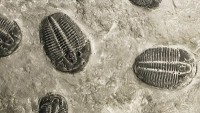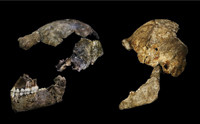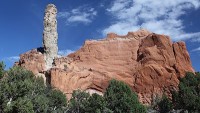The Moeraki Boulders of New Zealand tell a fascinating story. …read more Read more here: creation.com
Discovery of Water Deep Below Earth’s Surface May Confirm Biblical Accounts | Christian News Network
Scientists who have long been puzzled by the origins of Earth’s water are beginning to believe it originated deep inside of the planet—just like the Bible describes. Where did our planet’s water come from? This question remains a hotly-debated issue among geologists and astronomers, who concede that it is still largely a mystery. Evolutionists who believe the Earth was originally a hot molten sphere abounding with toxic gases have struggled to make sense of the abundance of water currently on our planet. ……. New scientific findings seem to support the Bible’s account. A report published recently in the journal “Nature” [More]
By Dr. Marcus Ross Winged reptiles were primitive, clumsy, “prehistoric” beasts, barely able to get off the ground, right? Take a closer look and see. …read more Read more here: AIG Daily
By Avery Foley Geologists claim their work with the fossil Dicynodon shows that the supposed terrestrial mass extinction happened before the marine extinction. …read more Read more here: AIG Daily
The question of Ice Ages proves more of a problem for secular scientists to answer than it does for creationists. …read more Read more here: creation.com
By Michael J. Oard Both the Ice Age and the many millions of woolly mammoths buried in Siberian permafrost have been major mysteries for about years despite numerous theories. …read more Read more here: AIG Daily
The largest volcano on Earth erupted catastrophically …read more Read more here: creation.com
Ice core discovery supports the creationist model of the post-Flood ice age. …read more Read more here: creation.com
By Dr. Andrew A. Snelling For decades, dinosaurs have troubled Christians who didn’t know how to explain them from the Bible. …read more Read more here: AIG Daily
By Dr. Elizabeth Mitchell Some believe the Gibbon-like fossil Pliobates cataloniae sheds light on the common ancestor supposedly shared by monkeys, apes, and humans. …read more Read more here: AIG Daily
By Troy Lacey Evidence of such large-scale catastrophes are yet another reminder that the present is not the key to the past. …read more Read more here: AIG Daily
By Dr. Andrew A. Snelling Terrestrial vertebrates close to the Flood fountains dissolved then precipitated out to form Precambrian-Cambrian sedimentary phosphate deposits. …read more Read more here: AIG Daily
By Dr. John Whitmore The Flood is impossible because one of the Grand Canyon’s layers was deposited in a desert. Or so evolutionists claim. Do the facts back them up? …read more Read more here: AIG Daily
A New Scientist article1 ponders a baffling enigma to evolutionists—‘living fossils’. These are creatures alive today which are identical to fossilised forms, believed to have lived ‘millions of years ago.’ Examples include the coelacanth fish (fossil coelacanths are believed by evolutionists to be 340 million years old2), Gingko trees (125 million years), crocodiles (140 million years), horseshoe crabs (200 million years), the Lingula lamp shell (450 million years), Neopilina molluscs (500 million years), and the tuatara lizard (200 million years). This poses a conundrum for evolution: ‘Why have these life-forms stayed the same for all that time?’This poses a conundrum [More]
Our first article on Homo naledi addressed questions about the anatomy and geologic setting of these fossils. Our second asked why these scientists chose to not date the fossils. This third and final article explores the question of how the fossils arrived in such a remote part of the cave. This may be the toughest of the three questions to answer. More… …read more Read more here: icr.org
‘If Noahs Flood really happened, then why don’t we see any evidence for it?’ a skeptic might ask. In today’s era of mass-media disinformation, this type of question is hurled at Bible-believers daily. The answer is quite simply this: evidence for Noah’s Flood is everywhere, but it is not reported as such by mainstream secular sources. A recent Associated Press article posted on the Guardian website provides us yet another perfect example of how evidence can be hidden in plain sight and presented in a completely dishonest way. Read More: Unpermineralized hadrosaur bones Alaska – creation.com
By Dr. Andrew A. Snelling The biblical worldview changes how you see everything, even a “paradise” like Hawaii. …read more Read more here: AIG Daily
When describing so-called ‘transitional’ fossils, we often call such fossils ‘mosaic fossils’. What do we mean? Read More: Mosaic fossils – creation.com
In the first of our three articles on this news-grabbing subject, we pointed out some strange circumstances surrounding the geology of the cave systems in which Homo naledi was discovered, as well as critical mismatches in bony body parts. This second article exposes a strange lack of evolutionary dating methods. Why has lead researcher Lee Berger, who is touring the world touting these fossils, not performed even one of several standard dating methods for fossils? More… …read more Read more here: icr.org
Recent claims of a transitional species named Homo naledi have the anthropologic world in an uproar. The new fossil “species” is said to be a human-like ancestor that neatly fills the gap between the Australopithecus and our own genus Homo. This seemingly fits the human evolution story promulgated since the 19th century, but what are these bones really? More… …read more Read more here: icr.org
How do we explain ‘apeman’ fossils from a biblical perspective? …read more Read more here: creation.com
By Frost Smith Scientists were hoping for insight into why so many fossilized dinosaurs are buried in rock appearing to be in what’s been called the “throes of death” posture. …read more Read more here: AIG Daily
The Lake Missoula flood can’t be tamed by spreading it over long periods of time. …read more Read more here: creation.com
‘Mud cracks’, as they are commonly called, form when muddy sediment is exposed to the air and dries out. This causes the mud to dehydrate, shrink and crack. Some Bible critics claim that mud cracks disprove the global flood, because they are supposedly found throughout the geological record, and therefore imply a series of prolonged periods of drying out, instead of one great watery cataclysm that laid down most sedimentary layers. However, this argument is far from ‘rock solid’, because true mud cracks are easy to confuse with cracks formed by other mechanisms that don’t involve a period of drying [More]
By Bill Hoesch Secluded in the canyon country of southern Utah is a beautiful but often overlooked state park called Kodachrome Basin. …read more Read more here: AIG Daily
Questionable assumptions about how volcanic andesite lava is produced suggests caution before accepting uniformitarian interpretations. …read more Read more here: creation.com
Fossil leaves show that leaf miners have existed along with leaves and questions the long ages attributed to these fossils. …read more Read more here: creation.com



































